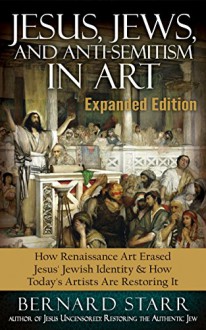Jesus, Jews, And Anti-Semitism In Art: How Renaissance Art Erased Jesus' Jewish Identity & How Today's Artists Are Restoring It
This provocative exposé reveals how Renaissance art took the Jew out of Jesus and calls for art historians, curators, and art critics to acknowledge this ethnic cleansing of Judaism in artworks. In depicting a Christian Jesus with no connection to Judaism, a vast trove of artworks, spanning...
show more
This provocative exposé reveals how Renaissance art took the Jew out of Jesus and calls for art historians, curators, and art critics to acknowledge this ethnic cleansing of Judaism in artworks.
In depicting a Christian Jesus with no connection to Judaism, a vast trove of artworks, spanning hundreds of years, perpetrated the illusion that Jesus and Jews were of different ethnicities and religions and in conflict, thus fueling anti-Semitism. Professor Starr shows how today's artists are putting Judaism back in the picture in an effort to heal the Christian/Jewish divide. This new expanded edition adds several chapters that deepen the exploration of the main themes of the book.
Jesus, Jews and Anti-Semitism in Art demonstrates that with rare exception, museum collections of Renaissance artworks typically portray Jesus as a fair-skinned northern European child or man in settings with Medieval and Renaissance saints and other Christian figures and artifacts. Artists in African and other cultures have pictured a dark-skinned, even a black Jesus, and they too omit his Jewish identity. This identity theft exacerbates differences between Jesus and Jews, when in fact they were all from the same Semitic tribe dedicated to Judaism. Moreover, these artworks, with their powerful imagery, either deliberately or inadvertently, reinforced the three pillars of anti-Semitism: Separate (Jesus is Christian, Jews are not), exaggerate differences (Jesus is like us, the Jews are not), and demonize (the Jews killed Jesus).
Art historians have rationalized these falsifications of biblical history by insisting that the contemporized images and settings were an expression of the Renaissance style and technical innovations in painting. But these explanations do not to hold up on close examination, especially when one views the dark menacing representations of Jews--the "others"--in artworks of the same period.
Starr cites numerous historical forces, dating from the beginnings of Christianity, that contributed to the divide between Christians and Jews, including Christianity's deliberate effort to separate itself from Judaism--a bumpy road given its early ties to Judaism. In addition, bans against the populace reading the New Testament on their own or translating the Bible into native languages prevented Christians--and Jews--from learning about the Jewish Jesus of the Gospels. Widespread persecution of Jews in the name of Jesus spanning the Medieval and Renaissance centuries intensified antagonism between the two faiths.
Despite these harsh historical conflicts, today’s Christians and Jews are increasingly recognizing common ground. In June, 2014 Pope Francis declared “Inside every Christian is a Jew.” This bold pronouncement heralds a new climate of reconciliation. Toward this end Bernard Starr is organizing a unique art exhibit that will strengthen the bond between Christians and Jews. In several important chapters he describes the exhibit and explains how it will put Judaism back in the picture, with new artworks that tell the two sides of the Jesus story: Jesus the dedicated Jew and Jesus whose life and teachings inspired a new religion. Examples of these works by the prominent participating artists are included in the last chapter.
show less

